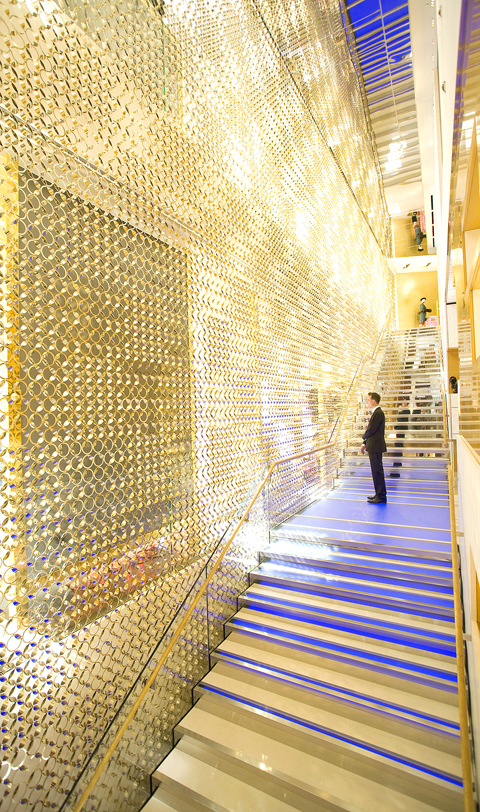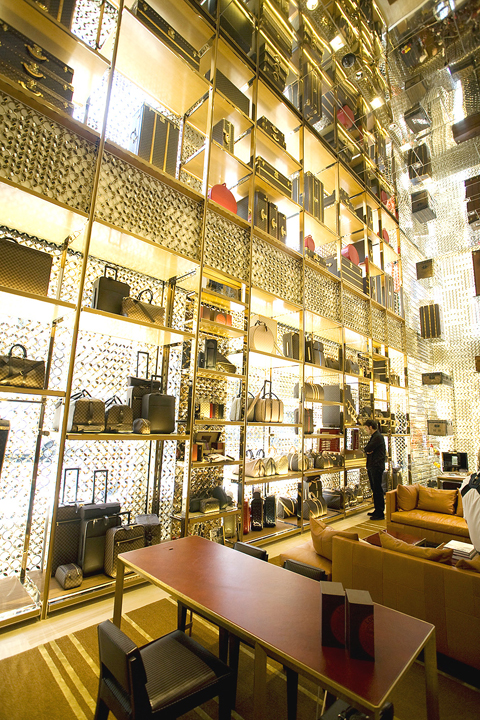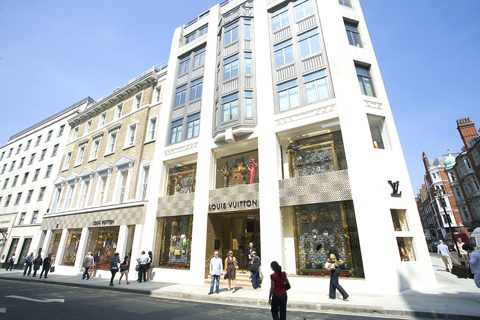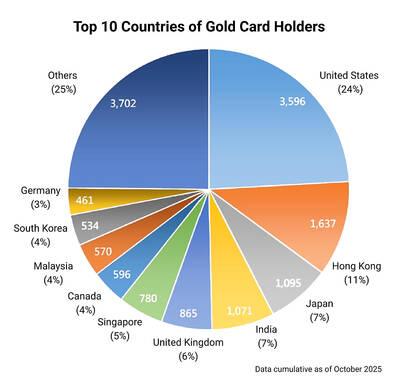At 10am on May 25, I was nestled into the deep plush of a velvet sofa three floors above Bond Street in central London with a mustached architect dressed head to toe in eyewateringly tight black leather. He talked in a breathy, conspiratorial whisper about philosophical happiness and had me bend down to join him in lovingly stroking the carpet, which, he told me, was woven in a little workshop he owns in the Caribbean. In a changing room nearby, everyone from old-school aristocrats (Lady Helen Taylor) to latest-edition paparazzi-darlings (Daisy Lowe) was wriggling in and out of dresses, choosing which “looks” to borrow for a glitzy dinner in the evening. On the ground floor, uberstylist Katie Grand was holding court in pink sunglasses while a cleaner flicked non-existent dust from a case containing Princess Margaret’s luggage. A moving sculpture by the artist Michael Landy entitled Credit Card Destroying Machine (component parts: antlers, teddy bears, rusty tools; and yes, it works) whirred away by the glass doors outside which Alexa Chung, in the midst of getting ready to host a live feed of party arrivals on Facebook, was having a cigarette break.
Welcome to the new Bond Street palace of Louis Vuitton, which takes the dark art of luxury retail to a new level. For starters — despite the racks of handbags, luggage and clothes — this flagship, which opened to the public on Friday, is not — repeat not — a shop. I was told many, many times before I even set foot in this three-years-in-the-making temple to the Louis Vuitton brand that it is a maison, not a store: “Reflecting Louis Vuitton’s art-de-vivre and savoir-faire, conceived as the home of a collector ... [it] gives visitors opportunities to discover new and exciting experiences.”
Which is daft, of course. But then the Louis Vuitton belief that retail is about emotion looks less and less silly with every set of figures the company releases. LVMH, the fashion house’s parent company, reported 11 percent sales growth in the first three months of this year, rewards reaped from audacious global expansion — last month, two new Louis Vuitton stores opened in Shanghai in one day — and from a strategy of focusing on the brand’s heritage in a more glamorous age of travel, which has hit a chord with customers. Research in Japan, where 60 percent of households own a genuine Louis Vuitton product, suggests consumers are prepared to pay 50 times as much for the real thing as for a fake, even if the products appear identical, because of the feeling of “specialness” they get when they purchase the real thing.

PHOTO: BLOOMBERG
The glass front of the Bond Street store is lined from floor to ceiling with a monogrammed golden chainmail that filters a sunny light on to the shopfloor. Facing you as you enter is a custom-made travel caviar set, in crocodile. (There is, of course, nothing as vulgar as a price tag.) Beyond, there is a wall of vintage trunks and another of current season luggage. The “bag bar,” where you can sit on a leather barstool and watch a moving display of handbags behind the counter, was inspired by the shooting-duck gallery of the funfair. (With Kiki, a giant sculpture by Japanese artist Takashi Murakami next to it, it also looks a little like a conveyor-belt sushi bar.)
At every turn, the boundaries between art and fashion are deliberately blurred. A huge self-portrait by Gilbert and George hangs between the two walls of men’s tailoring; in the exhibition space, Katie Grand, a longtime collaborator of the Louis Vuitton designer Marc Jacobs, has curated an exhibition of catwalk fashion. In the “library,” Barry Miles’ book, London Calling: A Countercultural History of London Since 1945, sits alongside limited-edition artists’ notebooks with covers by Gary Hume and Anish Kapoor. The top-floor “apartment,” where specially invited guests can make their selections in private, boasts a Basquiat, a Koons, another Gilbert and George, and two Richard Prince pieces.
Amid the walls of glossy bamboo and others wallpapered in silk and then hand-papered on-site with silver lacquer, and the hand-carved marble monograms sunk in the floor, architect Peter Marino cuts an improbable figure. He is dressed in his trademark biker leathers (custom-made at Dior), and completes the look with a cap and moustache. Marino, a flamboyant figure in the fashion world since his first job renovating a New York townhouse for his friend Andy Warhol, has become the go-to guy for jaw-dropping luxury flagship stores, including the Chanel Tower in Ginza, Tokyo, and the Christian Dior flagship in Paris.

PHOTO: BLOOMBERG
Just don’t call them luxury. “I am totally throwing up over the L word right now,” says Marino, who alone among the smooth, money-oiled LVMH machine is gloriously off-message. “The PR department will keep pushing that word, but since when did retail have to be so self-important and serious?” When Marino was first approached for this project, he refused — because he had designed the previous Louis Vuitton store on the same site, legend has it he said it would be “like eating my babies” — but he changed his mind. Are you happy now, I ask him? “Do you mean philosophically, or emotionally? I think maybe I’m too old now to be happy emotionally. But I try to be happy philosophically.” Actually, I say, I meant the store, do you like it? Marino throws his head back and laughs; his assistants and PR, hovering behind him, shoot nervous glances, clearly dying to rein him in. “The store! Of course. That’s hilarious. The thing is, I just want somewhere I feel good, a nice place to be, somewhere my wife would buy a handbag and then not be dying to get the hell out straight away. You know what I mean?”

PHOTO: BLOOMBERG

Seven hundred job applications. One interview. Marco Mascaro arrived in Taiwan last year with a PhD in engineering physics and years of experience at a European research center. He thought his Gold Card would guarantee him a foothold in Taiwan’s job market. “It’s marketed as if Taiwan really needs you,” the 33-year-old Italian says. “The reality is that companies here don’t really need us.” The Employment Gold Card was designed to fix Taiwan’s labor shortage by offering foreign professionals a combined resident visa and open work permit valid for three years. But for many, like Mascaro, the welcome mat ends at the door. A

Last week gave us the droll little comedy of People’s Republic of China’s (PRC) consul general in Osaka posting a threat on X in response to Japanese Prime Minister Sanae Takaichi saying to the Diet that a Chinese attack on Taiwan may be an “existential threat” to Japan. That would allow Japanese Self Defence Forces to respond militarily. The PRC representative then said that if a “filthy neck sticks itself in uninvited, we will cut it off without a moment’s hesitation. Are you prepared for that?” This was widely, and probably deliberately, construed as a threat to behead Takaichi, though it

Nov. 17 to Nov. 23 When Kanori Ino surveyed Taipei’s Indigenous settlements in 1896, he found a culture that was fading. Although there was still a “clear line of distinction” between the Ketagalan people and the neighboring Han settlers that had been arriving over the previous 200 years, the former had largely adopted the customs and language of the latter. “Fortunately, some elders still remember their past customs and language. But if we do not hurry and record them now, future researchers will have nothing left but to weep amid the ruins of Indigenous settlements,” he wrote in the Journal of

If China attacks, will Taiwanese be willing to fight? Analysts of certain types obsess over questions like this, especially military analysts and those with an ax to grind as to whether Taiwan is worth defending, or should be cut loose to appease Beijing. Fellow columnist Michael Turton in “Notes from Central Taiwan: Willing to fight for the homeland” (Nov. 6, page 12) provides a superb analysis of this topic, how it is used and manipulated to political ends and what the underlying data shows. The problem is that most analysis is centered around polling data, which as Turton observes, “many of these